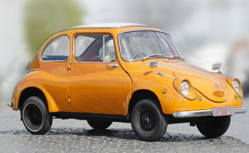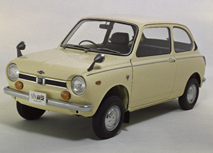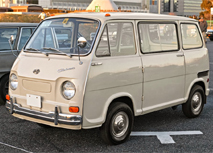The 1960's Subaru
1960's Subaru Timeline:
1968 Subaru first year in the USA.
1968 — 1969 Subaru 360. It's small.
This was the moment – the Subaru 360 hit America’s highways, it was cheap ($1,297!), and it was ugly. But it set in motion a company with a vision that appealed to what Americans were looking for. Although it did not exactly have the sports car look, it did offer practical, economical transportation to the first 600 drivers who put their faith in a product from a new company with Japanese heritage.
Replacing the Subaru 360...the Subaru R-2 was introduced in August 1969. Designed for the new era, the R-2 was a minisedan that attracted great interest for it's role in expanding the concept of the minicar. The R-2 performed well and was engineered for the "highway era" that Japan was entering, and its excellent balance meant the R-2 could be driven with ease on rough roads. With its refined style and roomy interior that could comfortably seat four people, the R-2 was a tribute to the Subaru engineers who built on their experience with the Subaru 360 to expand the minicar concept.
The Subaru Sambar truck made it's debut and was released in February 1961. The Sambar, based on the Subaru 360, was a truck that was outstandingly pleasant to ride and stable to drive. Compared with other four-wheel minitrucks of its day, the Subaru Sambar had the lowest deck body and the roomiest cargo bed. With its ability to neatly negotiate narrow street corners, this minitruck was a breath of fresh air in the industrial world. The following September, the Sambar Light Van was launched as a vehicle for not only commercial use, but also leisure use. With the Sambar, Subaru became firmly established as a manufacturer of light passenger vehicles.
The 4-door Subaru Sedan was released in May 1966 as FHI’s first compact passenger car powered by the boxer engine, the Subaru 1000 offered driving stability and a comfortable interior, as well as technical features such as the front-wheel drive platform, Horizontally-Opposed engine and centre-pivot steering wheel. The outstanding body design “befitting of a 1,500 cc model” combined with numerous proprietary functions stemming from FHI’s aeronautical background. The D.O.J. (double offset joint) constant velocity joint, inboard brakes and independent four-wheel suspension system helped to reduce the unsprung weight of the car. The 1000 redefined the front-wheel drive concept with its smooth and precise control, comfort and durability.
Subaru was among the leaders in the automotive industry who decided to produce more practical, engineering-driven vehicles – a path the company still follows, and one that still meets the needs of America’s motorists. Take a look at our earliest models and you’ll realize how far Subaru has come in the last 35 years. But while there’s little immediate resemblance between the unusually small Subaru 360 of the 1950s — 1950s and the first class Impreza WRX that currently occupies our showrooms, look closer and you’ll realize that thoughtful engineering, top-notch construction and remarkable fuel efficiency have been a part of every Subaru, and always will be.




